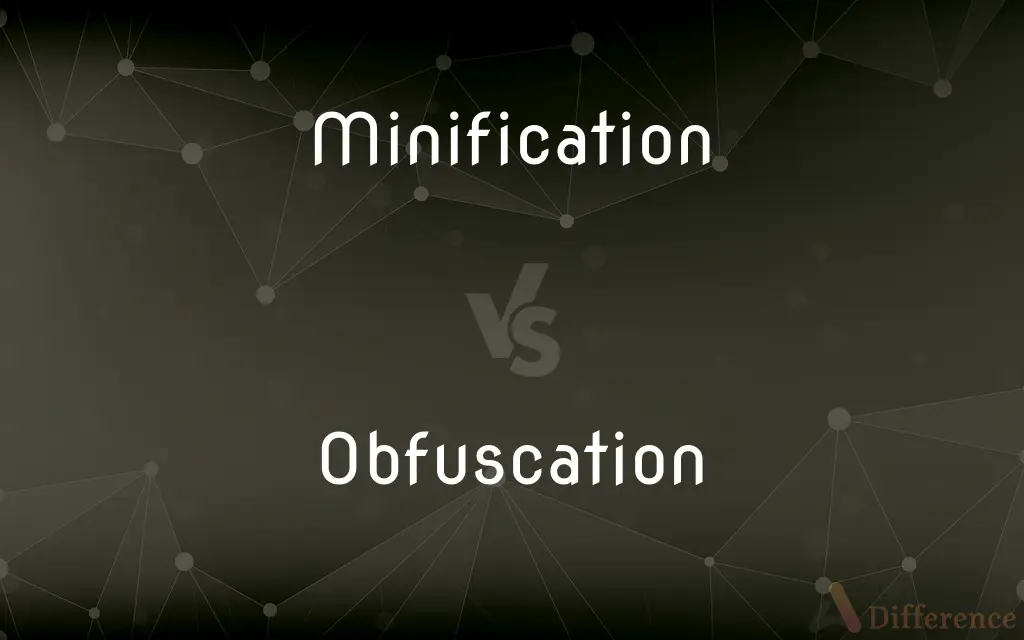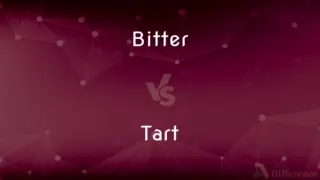Minification vs. Obfuscation — What's the Difference?
By Tayyaba Rehman — Updated on September 28, 2023
Minification is the process of compressing code by removing unnecessary characters, while obfuscation alters the code to make it difficult to understand, both aiming to optimize and secure software.

Difference Between Minification and Obfuscation
Table of Contents
ADVERTISEMENT
Key Differences
Minification and obfuscation are techniques used primarily in software development to optimize and secure code, but they serve different purposes. Minification is the process of removing all unnecessary characters from the source code without changing its functionality, such as whitespace, new line characters, and comments, to reduce the size of the file, which can improve load times and performance. Obfuscation, on the other hand, is used to deliberately alter the code, making it difficult for humans to read and understand, aiming to protect intellectual property and sensitive information within the code from unauthorized access and reverse engineering.
While minification focuses on optimizing code by compressing it, reducing the amount of data that needs to be transferred over the network, obfuscation emphasizes on securing the code. Minification achieves optimization by eliminating redundant data, which also makes the code slightly harder to read but does not inherently change the code structure or the names of variables, functions, etc. Obfuscation makes the code more secure by changing variable names to non-meaningful names and altering the code structure, which can deter tampering and reverse engineering but does not necessarily reduce file size.
In practical application, minification is often used in web development to decrease the loading time of websites by minimizing the size of JavaScript, CSS, and HTML files, making the web page more efficient and improving user experience. In contrast, obfuscation is more commonly employed in software development to protect the source code of applications, especially when the software contains proprietary algorithms or business logic, securing it against potential threats and intellectual property theft.
Minification can be easily reversed or "beautified" to a more readable format using online tools, as it only removes unnecessary characters and does not alter the logic of the code. Obfuscation, due to its altering of code logic and structure, is more difficult to reverse, providing a higher level of security against those who might want to understand the internal workings of the software.
In essence, minification is about optimization, reducing file sizes to enhance performance, especially in web development, while obfuscation is about security, altering code to protect intellectual property and sensitive information within software applications.
ADVERTISEMENT
Comparison Chart
Primary Purpose
Optimize code by removing unnecessary characters.
Secure code by making it difficult to understand.
Impact on Code Readability
Makes code slightly harder to read.
Makes code significantly harder to understand.
Reversibility
Easily reversible to a more readable format.
Difficult to reverse due to altered code structure.
Impact on File Size
Reduces file size significantly.
May not necessarily reduce file size.
Usage Context
Commonly used in web development for performance.
Used to protect intellectual property in software.
Compare with Definitions
Minification
An optimization method to improve load times and resource efficiency.
The minification of code resources contributed to the overall efficiency of the web application.
Obfuscation
A security measure to safeguard software against tampering and intellectual property theft.
Many software developers incorporate obfuscation to protect their proprietary code.
Minification
A form of code compression to enhance web page loading speed.
The use of minification is essential for improving user experience on the web.
Obfuscation
The act of making code difficult to understand to secure it.
Obfuscation was employed to protect the proprietary algorithms in the software.
Minification
A technique to optimize the file size of code for faster network transfers.
Developers often use minification to optimize CSS and HTML files for better performance.
Obfuscation
A technique to secure intellectual property within software by hindering comprehension.
Obfuscation ensures the protection of sensitive information within the code.
Minification
A process to eliminate redundant data in code without altering its functionality.
Minification tools are widely used to eliminate unnecessary whitespace and comments from code.
Obfuscation
Obfuscation is the obscuring of the intended meaning of communication by making the message difficult to understand, usually with confusing and ambiguous language. The obfuscation might be either unintentional or intentional (although intent usually is connoted), and is accomplished with circumlocution (talking around the subject), the use of jargon (technical language of a profession), and the use of an argot (ingroup language) of limited communicative value to outsiders.In expository writing, unintentional obfuscation usually occurs in draft documents, at the beginning of composition; such obfuscation is illuminated with critical thinking and editorial revision, either by the writer or by an editor.
Minification
The process of compressing code by removing unnecessary characters.
Website load times were improved through the minification of JavaScript files.
Obfuscation
To make so confused or opaque as to be difficult to perceive or understand
"A great effort was made ... to obscure or obfuscate the truth" (Robert Conquest).
Minification
The reduction in apparent size of objects viewed through a lens or mirror shaped so as to increase the field of view, such as a convex or aspheric mirror or a Fresnel lens.
Obfuscation
To render indistinct or dim; darken
The fog obfuscated the shore.
Minification
(computing) The removal of white space and unnecessary characters from a web page's source code in order to reduce its size and improve download time.
Obfuscation
(uncountable) The act or process of obfuscating, or obscuring the perception of something; the concept of concealing the meaning of a communication by making it more confusing and harder to interpret.
Obfuscation
The alteration of computer code to preserve its behavior while concealing its structure and intent.
You need to turn on obfuscation for these classes.
Obfuscation
(uncountable) Confusion, bewilderment, or a baffled state resulting from something obfuscated, or made more opaque and muddled with the intent to obscure information.
Obfuscation
(countable) A single instance of intentionally obscuring the meaning of something to make it more difficult to grasp.
During the debate, the candidate sighed at his opponent's obfuscations.
Obfuscation
The act of darkening or bewildering; the state of being darkened.
Obfuscation
Confusion resulting from failure to understand
Obfuscation
The activity of obscuring people's understanding, leaving them baffled or bewildered
Obfuscation
Darkening or obscuring the sight of something
Obfuscation
A method to alter code structure and variable names to deter reverse engineering.
Developers use obfuscation to secure the business logic within applications.
Obfuscation
A process to modify code, making it confusing and hard to interpret.
Obfuscation adds a layer of security against unauthorized access to the software’s internals.
Common Curiosities
Is minification reversible?
Yes, minification can be easily reversed to a more readable format using online tools or "beautifiers."
Can obfuscation be easily reversed?
No, obfuscation is more difficult to reverse due to the altered logic and structure of the code.
What is the main purpose of minification?
Minification primarily aims to optimize code by removing unnecessary characters, improving load times and performance.
How does obfuscation secure code?
Obfuscation secures code by altering its structure and making it difficult to understand, deterring reverse engineering and tampering.
Share Your Discovery

Previous Comparison
Compose vs. Consist
Next Comparison
Bitter vs. TartAuthor Spotlight
Written by
Tayyaba RehmanTayyaba Rehman is a distinguished writer, currently serving as a primary contributor to askdifference.com. As a researcher in semantics and etymology, Tayyaba's passion for the complexity of languages and their distinctions has found a perfect home on the platform. Tayyaba delves into the intricacies of language, distinguishing between commonly confused words and phrases, thereby providing clarity for readers worldwide.
















































